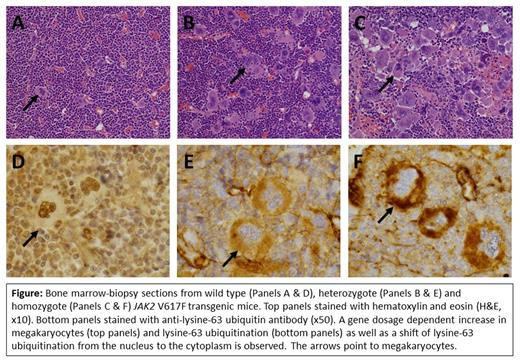Abstract
Introduction
The myeloproliferative neoplasms (MPN), polycythemia vera (PV), essential thrombocytosis and primary myelofibrosis are clonal hematopoietic stem cell disorders that arise from gain of function mutations that directly or indirectly activate JAK2, the cognate tyrosine kinase of the growth factor receptors for erythropoietin, thrombopoietin, and granulocyte colony-stimulating factor. Normally, JAK2 activation is modulated by the adapter protein LNK. However, this mechanism and how MPN mutations that activate JAK2 constitutively bypass LNK modulation are unknown. Clinically, loss of function LNK mutations mimic the MPN phenotype. LNK interacts with BRISC (BRCC36 isopeptidase complex) a lysine63-specific four member deubiquitinating complex. MERIT40 (Mediator of RAP80 Interactions and Targeting 40 kDa), the core subunit of BRISC, is necessary for both stability and activity of the BRISC deubiquitinating complex. This LNK-BRISC interaction suggested that deubiquitination might be a potential mechanism by which LNK could negatively regulate JAK2. We, therefore, examined the behavior of LNK, BRISC and MERIT40 in the context of JAK2 V617F.
Methods
We used a JAK2 V617F transgenic mouse PV model and a JAK2 V617F-expressing human cell line, DAMI, to examine JAK2 ubiquitination. The JAK2 V617F transgenic mouse, whether heterozygotic (VF) or homozygotic (VF/VF), authentically recapitulated human PV in a gene dosage-dependent manner: VF mice developed PV by 6 weeks, and splenomegaly and myelofibrosis by 30 weeks, while VF/VF mice demonstrated greater thrombocytosis, neutrophilia and erythrocytosis, with corresponding splenomegaly and fibrosis evident by 21 weeks.
Results
MERIT40 protein expression was found to be decreased in the JAK2 V617F transgenic mouse. Given the critical role of MERIT40 in BRISC protein stability and function, protein expression of both BRCC36 and LNK were assessed and also found to be decreased. Since we previously observed that BRISC activity is targeted to different proteins and cellular locations by interacting with different adaptor proteins (Patterson-Fortin et al. 2010; Zheng et al. 2013), we asked if LNK targeted BRISC deubiquitinating activity to JAK2. Lysates of unfractionated bone marrow from WT and VF mice were immunoprecipitated with a JAK2 antibody. The blots were probed with antibodies targeting lysine63-linked ubiquitin. JAK2 was robustly deubiquitinated in bone marrow samples from WT mice, whereas not only was this debubiquitination lost in in bone marrow samples from VF mice, there was also increased JAK2 phosphorylation. In the human DAMI cell model, MERIT40, LNK and BRISC protein levels were also all reduced, and JAK2 retained dramatic levels of lysine63-linked ubiquitin. Furthermore, we were able to rescue JAK2 deubiquitination in DAMI cells by transfecting MERIT40.
We next performed immunohistochemistry on bone marrow samples from WT, VF and VF/VF age-matched mice (Figure). As expected, a JAK2 V617F gene dosage-dependent increase in megakaryocytes was observed with VF/VF mice having the greatest increase. Importantly, in contrast to WT mice, VF-positive megakaryocytes demonstrated cytoplasm localization of lysine63-linked ubiquitin and loss of this signal in the nucleus, most striking in VF/VF mice.
Conclusions
We employed a gene dosage-dependent JAK2 V617F transgenic mouse model of PV and human DAMI cells to demonstrate for the first time that activated JAK2 avoids LNK inhibition because both LNK and MERIT40, a core subunit of the BRISC deubiquitinating complex, are downregulated. This leads to increased JAK2 lysine63-linked ubiquitination and increased JAK2-mediated signaling as evidenced by increased JAK2 phosphorylation. Additionally, there is a marked translocation of the lysine63-linked ubiquitination complex from the nucleus to the cytoplasm in the JAK2 V617F context. These results establish that normally LNK negatively regulates JAK2 activity by targeting a lysine63-deubiquitinating complex to the JAK2 protein. This leads to deubiquitination and suppression of JAK2 activity. In contrast, in the constitutively-activated JAK2 V617F context, down regulation of LNK and MERIT40, and possibly lysine63-linked ubiquitin redistribution, results in loss of negative regulation, perpetuating JAK2 signaling. These data suggest that deubiquitinating agents could be a novel targeted therapy in MPN.
No relevant conflicts of interest to declare.
Author notes
Asterisk with author names denotes non-ASH members.


This feature is available to Subscribers Only
Sign In or Create an Account Close Modal